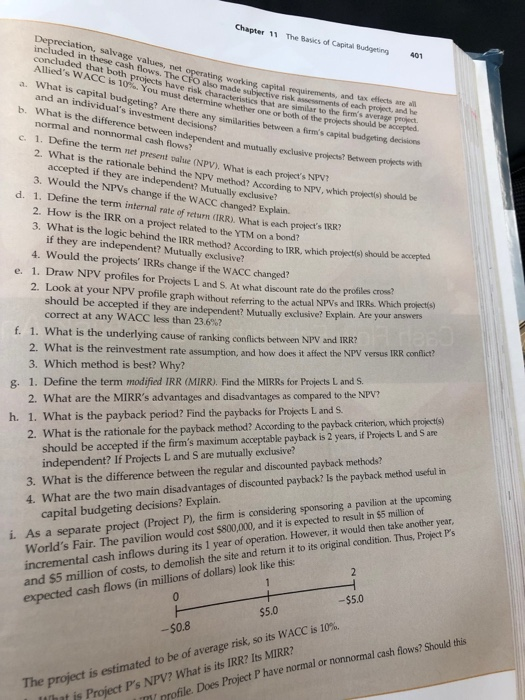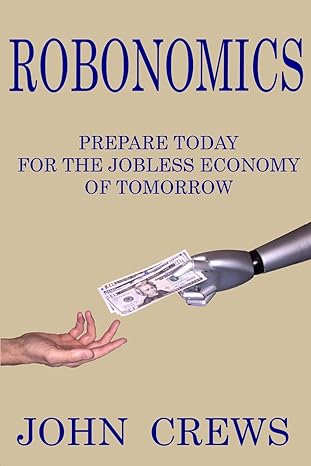Answered step by step
Verified Expert Solution
Question
1 Approved Answer
Chapter 11 The Basiks of Capital Budgeting uded in these cash fowrating working capital req concluded that both on, salvage values, net lows. The CFO
 Chapter 11 The Basiks of Capital Budgeting uded in these cash fowrating working capital req concluded that both on, salvage values, net lows. The CFO also made subijective risk projects have risk characteristics that are similar to the frms 401 Allied's WACC is 10% You must determine whether one or both of the projects and an individual's investment decisions? normal and nonnormal cash flows? 2. What is the rationale behind the NPV method? According to NT g working capital requirements, and tax effects are al a. What is capital budgeting? Are there any similarities between a firm's capital budgeting b. What is the difference between independent and mutually exclusive c. 1. Define the term net present value (NPV). What is each project's assessments of each project, and he each project, and be average peoject should be accepted decisions projects? Between projects with accepted if they are independent? Mutually exclusive? 3. Would the NIPVs change if the WACC dhanged? Explain. d. 1. Define the term internal rate of return (IRR). What is each projeet's IRR rate 2. How is the IRR on a project related to the YTM on a bond? 3. What is the logic behind the IRR method? According to IRR, which projectfs) should be aceped if they are independent? Mutually exclusive? 4. Would the projects' IRRs change if the WACC changed? e. 1. Draw NPV profiles for Projects L and S. At what discount rate do the profiles cross 2. Look at your NPV profile graph without referring to the actual NPVs and IRRs Which projectis) should be accepted if they are independent? Mutually exclusive? Explain. Are your answers correct at any WACC less than 236%? 1. What is the underlying cause of ranking conflicts between NPV and IRR? 2. What is the reinvestment rate assumption, and how 3. Which method is best? Why? f. does it affect the NPV versus IRR conflict? g. 1. Define the term modified IRR (MIRR). Find the MIRRs for Projects L and S 2. What are the MIRR's advantages and disadvantages as compared to the NPV? 1. What is the payback period? Find the paybacks for Projects L and s 2. What is the rationale for the payback method? According to the payback criterion, which projectis) h. independent? If Projects L and S are mutually exclusive? 3. What is the difference between the regular and discounted payback methods? 4. What are the two main disadvantages of discounted payback? Is the payback method useful in should be accepted if the firm's maximum acceptable payback is 2 years, if Projcts L and S are World's Fair. The pavilion would cost $800,000, and it is expected to result in $5 million of incremental cash and $5 million of costs, to expected cash flows (in millions of dollars) look like this inflows during its 1 year of operation. However, it would then take another year, demolish the site and returnm it to its original condition. Thus, Project P's capital budgeting decisions? Explain i. As a separate project (Project P), the firm is considering sponsoring a pavilion at the upcoming -$5.0 $5.0 -50.8 What is its IRR? Its MIRR profile. Does Project P have normal or nonnormal cash flows? Should this The project is estimated to be of average risk, so its WACC is 10% hat is Project P's NPV
Chapter 11 The Basiks of Capital Budgeting uded in these cash fowrating working capital req concluded that both on, salvage values, net lows. The CFO also made subijective risk projects have risk characteristics that are similar to the frms 401 Allied's WACC is 10% You must determine whether one or both of the projects and an individual's investment decisions? normal and nonnormal cash flows? 2. What is the rationale behind the NPV method? According to NT g working capital requirements, and tax effects are al a. What is capital budgeting? Are there any similarities between a firm's capital budgeting b. What is the difference between independent and mutually exclusive c. 1. Define the term net present value (NPV). What is each project's assessments of each project, and he each project, and be average peoject should be accepted decisions projects? Between projects with accepted if they are independent? Mutually exclusive? 3. Would the NIPVs change if the WACC dhanged? Explain. d. 1. Define the term internal rate of return (IRR). What is each projeet's IRR rate 2. How is the IRR on a project related to the YTM on a bond? 3. What is the logic behind the IRR method? According to IRR, which projectfs) should be aceped if they are independent? Mutually exclusive? 4. Would the projects' IRRs change if the WACC changed? e. 1. Draw NPV profiles for Projects L and S. At what discount rate do the profiles cross 2. Look at your NPV profile graph without referring to the actual NPVs and IRRs Which projectis) should be accepted if they are independent? Mutually exclusive? Explain. Are your answers correct at any WACC less than 236%? 1. What is the underlying cause of ranking conflicts between NPV and IRR? 2. What is the reinvestment rate assumption, and how 3. Which method is best? Why? f. does it affect the NPV versus IRR conflict? g. 1. Define the term modified IRR (MIRR). Find the MIRRs for Projects L and S 2. What are the MIRR's advantages and disadvantages as compared to the NPV? 1. What is the payback period? Find the paybacks for Projects L and s 2. What is the rationale for the payback method? According to the payback criterion, which projectis) h. independent? If Projects L and S are mutually exclusive? 3. What is the difference between the regular and discounted payback methods? 4. What are the two main disadvantages of discounted payback? Is the payback method useful in should be accepted if the firm's maximum acceptable payback is 2 years, if Projcts L and S are World's Fair. The pavilion would cost $800,000, and it is expected to result in $5 million of incremental cash and $5 million of costs, to expected cash flows (in millions of dollars) look like this inflows during its 1 year of operation. However, it would then take another year, demolish the site and returnm it to its original condition. Thus, Project P's capital budgeting decisions? Explain i. As a separate project (Project P), the firm is considering sponsoring a pavilion at the upcoming -$5.0 $5.0 -50.8 What is its IRR? Its MIRR profile. Does Project P have normal or nonnormal cash flows? Should this The project is estimated to be of average risk, so its WACC is 10% hat is Project P's NPV

Step by Step Solution
There are 3 Steps involved in it
Step: 1

Get Instant Access to Expert-Tailored Solutions
See step-by-step solutions with expert insights and AI powered tools for academic success
Step: 2

Step: 3

Ace Your Homework with AI
Get the answers you need in no time with our AI-driven, step-by-step assistance
Get Started


